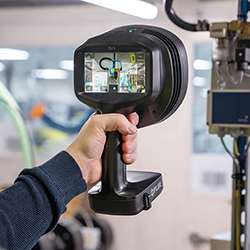The impact of 3D printing on social development
With the continuous development and innovation of technology, the 3D printing industry has gradually emerged and demonstrated great potential in various fields.
3D pri
nting technology is a rapid manufacturing technology that can transform virtual objects into physical objects by stacking materials layer by layer based on digital models. With the continuous development and innovation of technology, the 3D printing industry has gradually emerged and demonstrated great potential in various fields.Since its birth in the 1980s, 3D printing technology has experienced a leapfrog development from a prototype manufacturing tool to an industrialized production method. According to the Wohlers Report 2023, the global 3D printing industry has exceeded US$20 billion, with an average annual growth rate of 17.5%. This technology breaks the physical limitations of traditional subtractive manufacturing by stacking materials layer by layer, and its "design is production" feature is reshaping the production organization model of human society.1. The Reconstruction of Industrial Economy by 3D Printing Technology1)Decentralization of production processesTraditional manufacturing relies on centralized factories and complex supply chains, while 3D printing makes distributed manufacturing possible. For example, Siemens Energy deployed a mobile printing center at the Antarctic research station to manufacture repair parts on site, reducing equipment downtime by 80%. This "on-demand production, nearby delivery" model has reduced global logistics costs by about 12% (McKinsey, 2022).2)Promoting innovative development of manufacturing industryThe product development cycle of traditional manufacturing is long, but 3D printing technology can achieve rapid customization and rapid prototyping, greatly shortening the product development cycle. Enterprises can quickly verify design solutions through 3D printing technology, reduce trial and error costs and time, and improve product competitiveness.Products that require multiple processes to produce in traditional manufacturing can be formed in one go with the application of 3D printing technology, reducing process and labor costs. At the same time, 3D printing technology can also achieve mass customization production, meet personalized needs, and improve production efficiency.3)Liberalization breakthrough in product designAdditive manufacturing has gotten rid of mold restrictions, making complex structures (such as topologically optimized components) possible. Boeing integrated 20 components into a single component through 3D-printed fuel nozzles, reducing weight by 25%, increasing strength by 300%, and significantly improving aircraft engine performance.3)Reshaping the resilience of supply chainsThe COVID-19 pandemic exposed the fragility of the global supply chain, and 3D printing technology has alleviated this problem through localized production. In 2020, an Italian company used 3D printers to produce breathing valve accessories within 48 hours, breaking through the difficulties of traditional supply chain disruptions. This capability has reduced the company's inventory costs by 30%-50%, while shortening the launch cycle of new products by 60% (Deloitte, 2021).4)additive manufacturing deconstructs traditional industries3D printing technology breaks through the limitations of traditional processes such as mold forming and cutting by stacking materials layer by layer. This change enables the lightweight design of topologically optimized components in the aerospace field. For example, the C919 passenger aircraft of COMAC uses 3D printed titanium alloy door hinges, which reduces weight by 38% while improving fatigue resistance.2.Disruptive innovation in the social and people's livelihood fields1)Realization of precision medicine3D printing technology has been successfully applied to orthopedic implants, crown customization and other fields. Invisible braces from Align Technology in the United States are directly printed through patient oral scan data, shortening the correction cycle by 40%. Bioprinting technology has made breakthroughs in the regeneration of skin, cartilage and other tissues. In 2023, Israeli scientists successfully printed a prototype of an artificial heart with a vascular network.2)Promotion of inclusive medicineDeveloping countries have used low-cost 3D printed prostheses (such as the open source prosthetic hands of the e-NABLE community) to reduce the cost of rehabilitation for disabled people from tens of thousands of dollars to less than $50, benefiting more than 100,000 patients worldwide.3)Practical transformation of educational innovationPrimary and secondary schools use 3D printing laboratories to visualize STEM education (science, technology, engineering, and mathematics). For example, students can print molecular structure models to study chemical reactions, or make water conservancy engineering sand tables to simulate flood control designs. This "from virtual to physical" transformation increases the efficiency of understanding abstract concepts by 45% (UNESCO, 2022).3.Deeper challenges caused by technology diffusion1)Labor market polarization growsThe automated nature of 3D printing may lead to a reduction in traditional manufacturing jobs. 3D printing has reduced the demand for traditional jobs such as mold technicians by 40%, while the job gap for digital modelers has reached 1.2 million. The average cost of training for blue-collar workers in the manufacturing industry will rise to 82,000 yuan per person in 2024.The International Labor Organization (ILO) predicts that by 2030, about 5% of the world's manufacturing jobs will be replaced by 3D printing.2)The ethical dilemma of bioprintingClinical trials of human cell-printed organs have sparked controversy over the "commercialization of life". In 2024, 23 countries around the world will legislate to restrict the types of human tissues that can be printed.3D printing technology is evolving from a manufacturing tool to a catalyst for social change. It triggers not only innovation in production methods, but also a comprehensive reconstruction of the operating rules of human society.3D printing technology is not only a revolution in manufacturing tools, but also a profound change in human thinking and social operation logic. It has shown great potential in improving production efficiency, promoting social equity, and promoting sustainable development, but we must also be vigilant against the risk of technology getting out of control. Only through the coordinated evolution of technological innovation and institutional innovation can the social development vision of "technology for good" be realized.Featured Product

Affordable Excellence: The Go-To Tool for Finding Compressed Air Leaks
Find compressed air leaks fast with FLIR's new cutting-edge Si1-LD acoustic imaging camera. Leveraging advanced ultrasonic technology and onboard analytics, this affordable camera pinpoints leaks and quantifies incurred losses even in the nosiest environments. Upgrade your maintenance routine with the cost-effective FLIR Si1-LD - significantly reduce energy costs and increase system uptime. Get Started Today.
